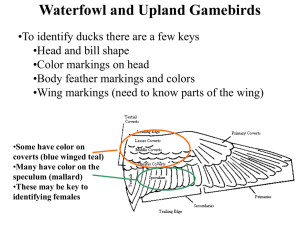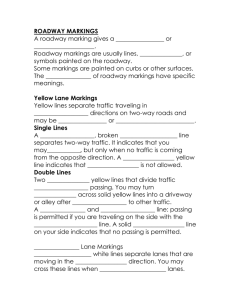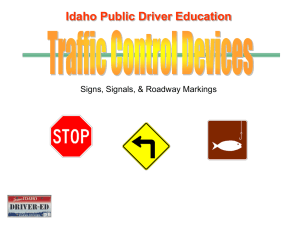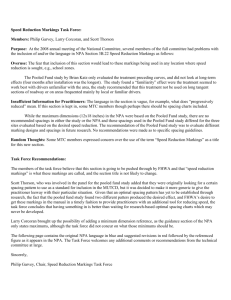Attach No. 10 Mark Comm Recomm Appvd 1-10 & 12-08
advertisement
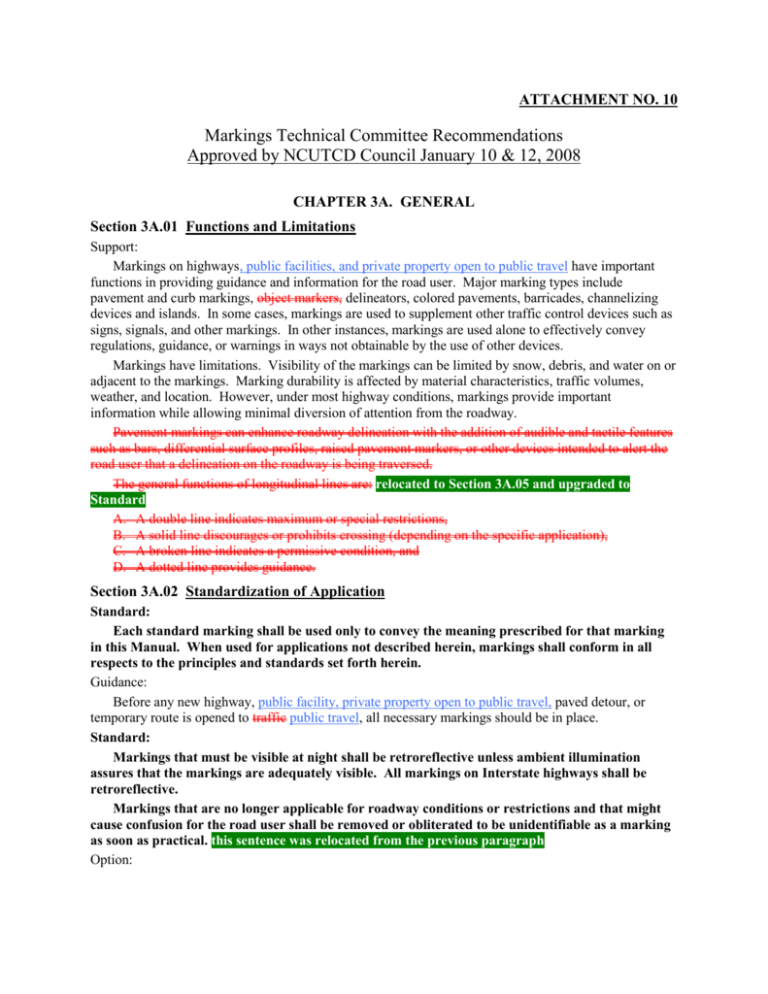
ATTACHMENT NO. 10 Markings Technical Committee Recommendations Approved by NCUTCD Council January 10 & 12, 2008 CHAPTER 3A. GENERAL Section 3A.01 Functions and Limitations Support: Markings on highways, public facilities, and private property open to public travel have important functions in providing guidance and information for the road user. Major marking types include pavement and curb markings, object markers, delineators, colored pavements, barricades, channelizing devices and islands. In some cases, markings are used to supplement other traffic control devices such as signs, signals, and other markings. In other instances, markings are used alone to effectively convey regulations, guidance, or warnings in ways not obtainable by the use of other devices. Markings have limitations. Visibility of the markings can be limited by snow, debris, and water on or adjacent to the markings. Marking durability is affected by material characteristics, traffic volumes, weather, and location. However, under most highway conditions, markings provide important information while allowing minimal diversion of attention from the roadway. Pavement markings can enhance roadway delineation with the addition of audible and tactile features such as bars, differential surface profiles, raised pavement markers, or other devices intended to alert the road user that a delineation on the roadway is being traversed. The general functions of longitudinal lines are: relocated to Section 3A.05 and upgraded to Standard A. A double line indicates maximum or special restrictions, B. A solid line discourages or prohibits crossing (depending on the specific application), C. A broken line indicates a permissive condition, and D. A dotted line provides guidance. Section 3A.02 Standardization of Application Standard: Each standard marking shall be used only to convey the meaning prescribed for that marking in this Manual. When used for applications not described herein, markings shall conform in all respects to the principles and standards set forth herein. Guidance: Before any new highway, public facility, private property open to public travel, paved detour, or temporary route is opened to traffic public travel, all necessary markings should be in place. Standard: Markings that must be visible at night shall be retroreflective unless ambient illumination assures that the markings are adequately visible. All markings on Interstate highways shall be retroreflective. Markings that are no longer applicable for roadway conditions or restrictions and that might cause confusion for the road user shall be removed or obliterated to be unidentifiable as a marking as soon as practical. this sentence was relocated from the previous paragraph Option: Until they can be removed or obliterated, markings may be temporarily masked with tape that is approximately the same color as the pavement until they can be removed or obliterated. Section 3A.03 Materials Support: Pavement and curb markings are commonly placed by using paints or thermoplastics; however, other suitable marking materials, including raised pavement markers and colored pavements, are also used. Delineators, object markers, barricades, and channelizing devices are visibly placed in a vertical position similar to signs above the roadway. Some marking systems consist of clumps or droplets of material with visible open spaces of bare pavement between the material droplets. These marking systems can function in a manner that is similar to the marking systems that completely cover the pavement surface and are suitable for use as pavement markings if they meet the other pavement marking requirements of the highway agency. Guidance: The materials used for markings should provide the specified color throughout their useful life. Consideration should be given to selecting pavement marking materials that will minimize tripping or loss of traction for road users, such as pedestrians, and bicyclists, and motorcyclists. Object markers and relocated to Section 2L.01 Delineators should not present a vertical or horizontal clearance obstacle for pedestrians. Section 3A.04 Colors Standard: Markings shall be yellow, white, red, or blue, or purple. The colors for markings shall conform to the standard highway colors. Black in conjunction with one of the above colors shall be a usable color. When used, white markings for longitudinal lines shall delineate: A. The separation of traffic flows in the same direction, or B. The right-hand edited to increase clarity edge of the roadway. When used, yellow markings for longitudinal lines shall delineate: A. The separation of traffic traveling in opposite directions, B. The left-hand edited to increase clarity edge of the roadways of divided and one-way highways and one-way streets or edited to increase consistency ramps, or C. The separation of two-way left-turn lanes and reversible lanes from other lanes. When used, red raised pavement markers or delineators shall delineate truck escape ramps and one-way roadways or ramps that shall not be entered or used in the direction from which the markers are visible. When used, blue markings shall supplement white markings for parking spaces for persons with disabilities. Support: Blue raised pavement markers can be used to indicate locations of fire hydrants along a roadway. Standard: When used, purple markings shall supplement lane line or edge line markings for toll plaza approach lanes that are used only by vehicles that are equipped for electronic toll collection (ETC) (see Section 3B.29). Option: Appropriate colors may be used in a route shield pavement marking symbol, such as red, white, and blue for an Interstate highway route shield pavement marking (see Figure 3B-25). Black may be used in combination with the above colors where a light-colored pavement does not provide sufficient contrast with the markings. Support: When used in combination with other colors, black is not considered a marking color, but only a contrast-enhancing system for the markings. Section 3A.05 Functions, Widths, and Patterns of Longitudinal Pavement Markings Standard: The general functions of longitudinal lines shall be: relocated from Section 3A.01 and upgraded to Standard A. A double line indicates maximum or special restrictions, B. A solid line discourages or prohibits crossing (depending on the specific application), C. A broken line indicates a permissive condition, and D. A dotted line provides guidance. The widths and patterns of longitudinal lines shall be as follows: A. A Normal line - 100 to 150 mm (4 to 6 in) wide. B. A Wide line - at least twice the width of a normal line. C. A Double line - two parallel lines separated by a discernible space. D. A Broken line - normal line segments separated by gaps. E. A Dotted line - noticeably shorter line segments separated by shorter gaps than used for a broken line. The width of a dotted line shall be at least the same as the width of the line it extends. Support: The width of the line shall indicates the degree of emphasis. Guidance: Broken lines should consist of 3 m (10 ft) line segments and 9 m (30 ft) gaps, or dimensions in a similar ratio of line segments to gaps as appropriate for traffic speeds and need for delineation. Support: Dotted lines are used to extend lines through intersections or interchanges. Dotted lines are also used instead of broken lane lines to separate a continuing lane from a non-continuing lane, such as acceleration or deceleration lanes, auxiliary lanes, lane drops, and lane reductions. Option Guidance: A dotted line for line extensions within an intersection or taper area may should consist of 0.6 m (2 ft) line segments and 0.6 m (2 ft) to 1.8 m (6 ft) gaps. A dotted line for lane drop/add markings used as a lane line to separate a continuing lane from a non-continuing lane may should consist of 0.9 m (3 ft) line segments and 2.7 m (9 ft) gaps. Section 3A.06 Definitions Relating to Pavement Markings Standard: The following technical terms, when used in Part 3, shall be defined as follows: 1. Neutral area—the paved area between the channelizing lines that separate an entrance or exit ramp and the adjacent through lane(s). 2. Physical gore—a longitudinal point where a physical barrier or the lack of a paved surface inhibits road users from crossing from a ramp to the adjacent through lane(s) or vice versa. 3. Theoretical gore—a longitudinal point at the upstream end of an exit ramp or island neutral area where the channelizing lines that separate the ramp or island from the adjacent through lane(s) begin to diverge or a longitudinal point at the downstream end of an entrance ramp or island neutral area where the channelizing lines that separate the ramp or island from the adjacent through lane(s) intersect each other. CHAPTER 3C. ROUNDABOUT MARKINGS edited from Sections 3B.24 and 3B.25 Section 3B.24 3C.01 Markings for Roundabout Intersections General Support: Roundabout intersections are distinctive circular roadways that have the following three critical characteristics: A. A requirement to yield at entry which gives a vehicle on the circular roadway the right-of-way, B. A deflection of the approaching vehicle around the central island, and C. A flare or widening of the approach to allow for proper operation as needed. Standard: Roundabouts shall be defined as circular intersections that meet the following characteristics: A. Yield at entry to vehicles that are traveling on the circulatory roadway; and B. Deflection of the approaching vehicle in a counter-clockwise direction around the central island. Pavement markings and signing at roundabouts shall present a consistent message to the road user. Guidance: Pavement markings and signing for a roundabout should be integrally designed to correspond to the geometric design and intended lane use of a roundabout. Markings at roundabouts should facilitate the movement through the roundabout without requiring vehicles to change lanes within the circulatory roadway to exit the roundabout in a given direction. Markings on roundabout approaches should be compatible with circulatory roadway markings to provide a consistent message to road users at roundabouts. Option: Traffic control signals (see Part 4) may be used at roundabouts to facilitate the crossing of pedestrians in crosswalks or to allow metering of traffic. Section 3C.02 White Lane Line Pavement Markings for Roundabouts Standard: Multi-lane approaches to roundabouts shall have lane lines. Bicycle lane markings shall not be provided on the circular roadway of a roundabout intersection. Guidance: Bicycle lane markings should stop at least 30 m (100 ft) before the crosswalk, or if no crosswalk is provided, at least 30 m (100 ft) before the yield line, or if no yield line is provided, then at least 30 m (100 ft) before the edge of the circulatory roadway (see Chapter 9C for details.) Lane lines may be used on the circular roadway if there is more than one lane. Multi-lane roundabouts should have lane line markings within the circulatory roadway to channelize traffic to the appropriate exit lane. Standard: Continuous concentric lane lines shall not be used within the circulatory roadway of roundabouts. Section 3C.03 Edge Line Pavement Markings for Roundabouts Guidance: A white edge line should be used on the outer (right-hand edited to increase clarity) side of the circular circulatory roadway. If a white edge line is used for the circulatory roadway, it should be as follows (see Figure 3C-1): A. A solid line along adjacent to the splitter island, and B. A wide dotted line across the lane(s) entering the roundabout intersection. Standard: Edge line extensions should shall not be placed across the exits from the circular circulatory roadway at roundabouts. Option: A yellow edge line may be placed around the inner (left-hand edited to increase clarity) edge of the circular circulatory roadway (see Figure 3C-1) and may be used to channelize traffic (see Figure 3C-7). Section 3C.04 Yield Lines for Roundabouts Option: A yield line (see Section 3B.16) may be used to indicate the point behind which vehicles are required to yield at the entrance to a roundabout intersection (see Figure 3C-1). Section 3C.05 Crosswalk Markings at Roundabouts Standard: Pedestrian crosswalks shall not be marked to or from the central island of roundabouts. Guidance: If pedestrian facilities are provided, crosswalks (see Section 3B.18) should be marked across roundabout entrances and exits to indicate where pedestrians are intended to cross. Where crosswalk markings are used, these markings should be located a minimum of 7.6 m (25 ft) upstream from the yield line, or, if none, from the dotted white line. Crosswalks should be a minimum of 6.1 m (20 ft) from the edge of the circulatory roadway. Support: Figure 3C-2 illustrates examples of layouts for crosswalk markings at roundabouts. Section 3C.06 Pavement Word and Symbol Markings for Roundabouts Option: Lane use arrows may be used on any approach to and within the circulatory roadway of any roundabout. YIELD word pavement markings (see Figure 3C-1) andYIELD AHEAD (symbol or word) may be used on approaches to roundabouts. Word and/or route shield pavement markings may be used on an approach to or within the circulatory roadway of a roundabout to provide route and/or destination guidance information to road users (see Figure 3C-18). Guidance: Within the circulatory roadway of multi-lane roundabouts, standard lane use arrows (see Section 3B.20) should be used. On multi-lane approaches with double left-turn and/or double right-turn lanes, lane use arrows as shown in Figure 3C-3 should be used. Option: If used on approaches to a roundabout, lane-use arrows may be either standard or fish-hook arrows, either with or without an oval symbolizing the central island, as shown in Figure 3C-3. Section 3C.07 Example Markings for Roundabouts Support: Figures 3C-4 through 3C-18 illustrate examples of markings for roundabouts intersections are shown in Figures 3B-27 and 3B-28 of various geometric and lane-use configurations. Section 3B.25 3C.08 Markings for Other Circular Intersections Support: Other circular intersections include, but are not limited to, rotaries, traffic circles, and residential traffic calming designs. Option: The markings shown in Figures 3B-27 and 3B-28 this Chapter may be used at other circular intersections when if engineering judgment indicates that their presence will benefit drivers or pedestrians. CHAPTER 3D. DELINEATORS Section 3D.01 Delineators Support: Delineators are particularly beneficial at locations where the alignment might be confusing or unexpected, such as at lane-reduction transitions and curves. Delineators are effective guidance devices at night and during adverse weather. An important advantage of delineators in certain locations is that they remain visible when the roadway is wet or snow covered. Delineators are considered guidance devices rather than warning devices. Option: Delineators may be used on long continuous sections of highway or through short stretches where there are changes in horizontal alignment. Section 3D.02 Delineator Design Standard: Delineators shall be retroreflective devices mounted above the roadway surface and along the side of the roadway in a series to indicate the alignment of the roadway. Delineators shall consist of retroreflector units that are capable of clearly retroreflecting light under normal atmospheric conditions from a distance of 300 m (1,000 ft) when illuminated by the high beams of standard automobile lights. Retroreflective elements for delineators shall have a minimum dimension of 75 mm (3 in). Option: Elongated retroreflective units of appropriate size may be used in place of two retroreflectors mounted as a unit. Section 3D.03 Delineator Application Standard: The color of delineators shall conform to the color of edge lines stipulated in Section 3B.06. Single delineators shall be provided on the right-hand edited to increase clarity side of freeways and expressways and on at least one side of interchange ramps, except in one of the following cases (A or B): A. On tangent sections of freeways and expressways when all both of the following conditions are met: 1. Raised pavement markers are used continuously on lane lines throughout all curves and on all tangents to supplement pavement markings. 2. Where whole routes or substantial portions of routes have large sections of tangent alignment. 3. Roadside delineators are used to lead into all curves. B. On sections of roadways where continuous lighting is in operation between interchanges. Option: Delineators may be provided on other classes of roads. Single delineators may be provided on the left-hand edited to increase clarity side of roadways. Standard: Delineators on the left-hand side of a two-way roadway shall be white. Guidance: Single delineators should be provided on the outside of curves on interchange ramps. Where median crossovers are provided for official or emergency use on divided highways and where these crossovers are to be marked, a double yellow delineator should be placed on the left-hand edited to increase clarity side of the through roadway on the far side of the crossover for each roadway. Double or vertically elongated delineators should be installed at 30 m (100 ft) intervals along acceleration and deceleration lanes. Delineators should be used wherever guardrail or other longitudinal barriers are present. Option: Red delineators may be used on the reverse side of any delineator where it would be viewed by a road user traveling in the wrong direction on that particular a one-way ramp or roadway. Delineators of the appropriate color may be used to indicate a lane-reduction transition where either an outside or inside lane merges into an adjacent lane. Guidance: When used for lane-reduction transitions, the delineators should be used installed adjacent to the lane or lanes reduced for the full length of the transition and should be so placed and spaced to show the reduction (see Figure 3B-13). Support: Delineators are not necessary for traffic moving in the direction of a wider pavement or on the side of the roadway where the alignment is not affected by the lane-reduction transition. Guidance: On a highway with continuous delineation on either or both sides, delineators should be carried through transitions. Option: On a highway with continuous delineation on either or both sides, the spacing between a series of delineators may be closer. Standard: When used on a truck escape ramp, delineators shall be red. Guidance: Red delineators should be placed on both sides of truck escape ramps. The delineators should be spaced at 15 m (50 ft) intervals for a distance sufficient to identify the ramp entrance. Delineator spacing beyond the ramp entrance should be adequate for guidance according to the length and design of the escape ramp. Section 3D.04 Delineator Placement and Spacing Guidance: Delineators should be mounted on suitable supports so that at a minimum mounting height, measured vertically from the top bottom of the highest lowest retroreflector to the elevation of the near edge of the roadway, is of 1.2 m (4 ft) above the near roadway edge. Option: When mounted on the face of or on top of guardrails or other longitudinal barriers, delineators may be mounted at a lower elevation than the normal delineator height stated above. Guidance: They Delineators should be placed 0.6 to 2.4 m (2 to 8 ft) outside the outer edge of the shoulder, or if appropriate, in line with the roadside barrier that is 2.4 m (8 ft) or less outside the outer edge of the shoulder. Delineators should be placed at a constant distance from the edge of the roadway, except that where an obstruction intrudes into the space between the pavement edge and the extension of the line of the delineators, the delineators should be transitioned to be in line with or inside the innermost edge of the obstruction. If the obstruction is a guardrail, the delineators should be transitioned to be either grammar – more than two choices just behind, directly above (in line with), or on the innermost edge of the guardrail. Delineators should be spaced 60 to 160 m (200 to 530 ft) apart on mainline tangent sections. Delineators should be spaced 30 m (100 ft) apart on ramp tangent sections. Support: Examples of delineator installations are shown in Figure 3D-1. Option: When uniform spacing is interrupted by such features as driveways and intersections, delineators which would ordinarily be located within the features may be relocated in either direction for a distance not exceeding one quarter of the uniform spacing. Delineators still falling within such features may be eliminated. Delineators may be transitioned in advance of a lane transition or obstruction as a guide for oncoming traffic. Guidance: The spacing of delineators should be adjusted on approaches to and throughout horizontal curves so that several delineators are always simultaneously visible to the road user. The approximate spacing shown in Table 3D-1 should be used. Option: When needed for special conditions, delineators of the appropriate color may be mounted in a closely-spaced manner on the face of or on top of guardrails or other longitudinal barriers to form a continuous or nearly continuous “ribbon” of delineation. CHAPTER 3E. COLORED PAVEMENTS Section 3E.01 General paragraphs have been relocated within this Section Support: Colored pavements consist of differently colored road paving materials, such as colored asphalt or concrete, or paint or other marking materials applied to the surface of a road or island to simulate a colored pavement. When used for guidance or regulation of traffic, colored pavements are traffic control devices. If nonretroreflective colored pavements, including bricks and other types of patterned surfaces, also are sometimes is used to supplement other traffic control devices as a purely aesthetic treatment and is not intended to communicate a regulatory, warning, or guidance message to road users, the colored pavement is not considered to be a traffic control device, even if it is located between the lines of a crosswalk. Colored pavement located between crosswalk lines to emphasize the presence of the crosswalk is not considered to be a traffic control device. Standard: If colored pavements is used as within the traveled way, on flush or raised islands, or on shoulders to regulate, warn, or guide traffic or if retroreflective colored pavement is used, the colored pavement is considered to be a traffic control devices and shall be limited to the following colors and applications: A. Yellow pavement color shall be used only for flush or raised median islands separating traffic flows in opposite directions or for left-hand shoulders of roadways of divided highways or one-way streets or ramps. B. White pavement color shall be used for delineation on shoulders, and for flushed or raised channelizing islands where traffic passes on both sides in the same general direction or for right-hand shoulders. Colored pavements shall not be used as a traffic control device, unless the device is applicable at all times. Guidance: Colored pavements used as traffic control devices should be used only where they contrast significantly with adjoining paved areas. Colored pavement located between crosswalk lines should not use colors or patterns that degrade the contrast of white crosswalk lines, or that might be mistaken by road users as a traffic control application, should not be used for colored pavement located between crosswalk lines. CHAPTER 3G. ISLANDS Section 3G.01 General Support: Chapter 3G addresses the characteristics of islands as traffic-control devices. Criteria for the design of islands are set forth in “A Policy on Geometric Design of Highways and Streets” (see Section 1A.11). Standard: An island for traffic control purposes shall be the defined area between traffic lanes for control of vehicular movements, for toll collection, or for pedestrian refuge. Within an intersection area, a median or an outer separation shall be an island. Option: An island may be designated by curbs, pavement edges, pavement markings, channelizing devices, curbs, pavement edges, or other devices. Section 3G.02 Approach-End Treatment Guidance: The ends of islands first approached by traffic should be preceded by a gradually diverging longitudinal pavement markings on the roadway surface, to guide vehicles into desired paths of travel along the island edge. Option Support: The neutral area between approach-end markings that can be readily crossed even at considerable speed may sometimes contains slightly raised (usually less than 25 mm (1 in) high) sections of coarse aggregate or other suitable materials to create rumble sections that provide increased visibility of the marked areas and that produce an audible warning to road users traveling across them. For additional discouragement to driving in the neutral area, bars or buttons projecting 25 to 75 mm (1 to 3 in) above the pavement surface are sometimes placed in the neutral area. These bars or buttons are designed so that any wheel encroachment within the area will be obvious to the vehicle operator, but will result in only minimal effects on control of the vehicle. Such bars or buttons are sometimes preceded by rumble sections or their height is gradually increased as approached by traffic. Guidance: When raised bars or buttons are used in these neutral areas, they should be marked with white or yellow retroreflective materials, as determined by the direction or directions of travel they separate. relocated from Section 3G.03 Standard: Rumble strips or other Channelizing devices, when used in advance of islands having raised curbs, shall not be placed in such a manner as to constitute an unexpected obstacle. Guidance: Bars or buttons should not project more than 25 to 75 mm (1 to 3 in) above the pavement surface and should be designed so that any wheel encroachment within the area will be obvious to the vehicle operator, but will not result in loss of control of the vehicle. incorporated into the above Support paragraph Option: Bars or buttons may be preceded by rumble sections, or their height may be gradually increased as approached by traffic. incorporated into the above Support paragraph Pavement markings may be used with raised bars to better designate the island area. Section 3G.03 Island Marking Application Standard: Markings, as related to islands, shall consist only of pavement and curb markings, object markers, channelizing devices, and delineators. Guidance: Unless engineering judgment determines that there is not a need on the approach to a particular islands, the triangular neutral area in advance of the upstream end of the island shall should include pavement markings as described in Section 3B.10. Option: As indicated in Section 3G.02, rumble sections, or other similar traffic control designs which contrast with the pavement surface, may also be applied in the triangular neutral area in advance of the end of an island. Section 3G.04 Island Marking Colors Guidance: Islands outlined by curbs or pavement markings should be marked with retroreflective white or yellow material as determined by the direction or directions of travel they separate (see Section 3A.04). The retroreflective area should be of sufficient length to denote the general alignment of the edge of the island along which vehicles travel, including the approach nose, when viewed from the approach to the island. Option: On long islands, curb retroreflection may be discontinued such that it does not extend for the entire length of the curb, especially if the island is illuminated or marked with delineators or edge lines. Section 3G.05 Island Object Markers Option: Object markers (see Chapter 2L) may be installed alone or in combination with other signs (such as KEEP RIGHT Keep Right, KEEP LEFT Keep Left, double arrows, or guide signs) located within the island. Section 3G.06 Island Delineators Standard: Delineators installed on islands shall be the same colors as the related edge lines except that, when facing wrong-way traffic, they shall be red (see Section 3D.03). Each roadway through an intersection shall be considered separately in positioning delineators to assure maximum effectiveness. Section 3G.07 Pedestrian Islands and Medians Support: Raised islands or medians of sufficient width that are placed in the center area of a street or highway can serve as a place of refuge for pedestrians who are attempting to cross at a midblock or intersection location. Center islands or medians allow pedestrians to find an adequate gap in one direction of traffic at a time, as the pedestrians are able to stop, if necessary, in the center island or median area and wait for an adequate gap in the other direction of traffic before crossing the second half of the street or highway. The minimum widths for refuge islands are specified in the “Americans with Disabilities Act Accessibility Guidelines for Buildings and Facilities (ADAAG)” (see Section 1A.11). Placement of detectable warnings (see Section 3B.18) at the back of the curb line on curb ramps allows placement of the detectable warning behind depressed curbing. At cut-through islands or medians (see Figure 3G-1), detectable warnings can readily be placed such that they are even with or just behind the face of curb to increase the separation between the detectable warnings at the opposite sides of the island or median to better define the area of refuge. Increased separation also provides clearer information to pedestrians who have visual disabilities. CHAPTER 3H. RUMBLE STRIP MARKINGS Section 3H.01 Longitudinal Rumble Strip Markings Support: Longitudinal rumble strips consist of a series of rough-textured or slightly raised or depressed road surfaces intended to alert inattentive drivers through vibration and sound that their vehicle has left the travel lane. Shoulder rumble strips are typically installed along the shoulder near the travel lane. On divided highways, rumble strips are sometimes installed on the median side (left-hand side) shoulder as well as on the outside (right-hand side) shoulder. On two-way roadways, rumble strips are sometimes installed along the center line. The provisions in this Manual address the use of markings in combination with a longitudinal rumble strip. Option: An edge line or center line may be located over a longitudinal rumble strip to create a rumble stripe. Standard: If used, the edge line or center line associated with a longitudinal rumble stripe shall be white for the right-hand edge of the roadway, yellow for the left-hand edge of the roadways of divided and one-way highways and ramps, and yellow for the separation of traffic traveling in opposite directions. An edge line shall not be used in addition to a rumble stripe that is located along a shoulder. Section 3H.02 Transverse Rumble Strip Markings Support: Transverse rumble strips consist of intermittent narrow, transverse areas of rough-textured or slightly raised or depressed road surface that extend across the travel lanes to alert drivers to unusual vehicular traffic conditions. Through noise and vibration, they attract the attention of road users to features such as unexpected changes in alignment and conditions requiring a reduction in speed or a stop. The provisions in this Manual address the use of markings in combination with a transverse rumble strip. Standard: If the color of a transverse rumble strip used within a travel lane is not the color of the pavement, the color of the transverse rumble strip shall be white. Guidance: White transverse rumble strips used in a travel lane should not be placed in locations where they could be confused with other transverse markings such as stop lines or crosswalks. CHAPTER 5E. MARKINGS Section 5E.01 Introduction Support: The purpose of markings on highways is to provide guidance and information for road users regarding roadway conditions and restrictions. The criteria provisions edited to increase consistency for markings, delineators, and object markers, in general, are contained in Part 3 and in other Sections of this Manual. Criteria Provisions edited to increase consistency for markings that are specific to low-volume roads are contained in this Chapter. Section 5E.02 Centerline Center Line Markings Standard: Where centerline center line markings are installed, no-passing zone markings in conformance with Section 3B.02 shall also be installed. Guidance: Centerline Center line markings should be used on paved low-volume roads where engineering judgment or an engineering study indicates a need for them. Section 5E.03 Edge Line Markings Support: The purpose of edge line markings is to delineate the left-hand edited to increase clarity or right-hand edited to increase clarity edge of the roadway. Guidance: Edge line markings should be considered for use on paved low-volume roads based on engineering judgment or an engineering study. Option: Edge line markings may be placed on highways with or without centerline center line markings. Edge line markings may be placed on paved low-volume roads for roadway features such as horizontal curves, narrow bridges, pavement width transitions, curvilinear alignment, and at other locations based on engineering judgment or an engineering study. Section 5E.04 Delineators Support: The purpose of delineators is to enhance driver safety where it is desirable to call attention to a changed or changing condition such as abrupt roadway narrowing or curvature. Option: Delineators may be used on low-volume roads based on engineering judgment, such as for curves, Tintersections, and abrupt changes in the roadway width. In addition, they may be used to mark the location of driveways or other minor roads entering the low-volume road. Section 5E.05 was relocated to become Section 5C.14 Section 5E.06 5E.05 Other Markings Standard: Other markings, such as stop lines, crosswalks, pavement legends, barricades, channelizing devices, and islands, used on low-volume roads shall conform comply with the criteria provisions edited to increase consistency contained in this Manual.

